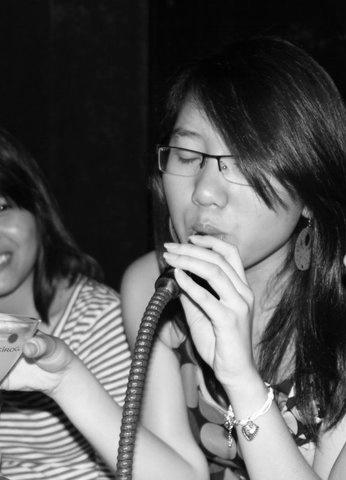
Shisha, more commonly known as hookah, is growing in popularity on U.S. college campuses. It is most popular amongst the 18-25 year demographic.
While cigarette smokers often use tobacco products to take a break from daily activities, hookah users report a pro-social setting associated with hookah consumption — typically a late Friday night or a warm Sunday on the grass.
A hookah is a multi-stemmed water pipe used to smoke flavored tobacco, mainly in large group setting. The apparatus originates from the north western provinces of India, and the tradition of its use spread through much of the Middle East and recently gained popularity in Western Europe and North America.
The tobacco is wet and soaked in molasses or honey, different from the dry leaves of a cigarette. “Packing a head” refers to the way that the tobacco is stuffed in the top of the pipe. A hot coal keeps a lit ember and is placed on a sheet of aluminum covering the packed tobacco.
The water pipe made its way across the middle-east and became an integral part of social gatherings among upper-class members of society, often associated with intellectuals.
As the hookah was adopted into this social sphere, the design of the water pipe evolved into the more stylistically-complex and bedazzled instrument that we are more familiar with today. Much of the design and the Middle Eastern association are likely what gives this pass-time activity its appeal.
In an interview with sophomore Kyla Ericson, an art house resident and hookah owner, she explained that it’s not really about tobacco consumption or rooted in nicotine addiction, but it’s used for pro-social bonding. It’s been adopted into a Friday night peace pipe, sans psychosomatic effects.
In a 2009 report, the National College Health Assessment Board reported that ten percent of those surveyed reported using a hookah within the past thirty days.
Kyla explained that she started smoking hookah while in high school, and it was always something that parents typically turned a blind eye toward.
In a telephone interview with marathon runner, flute performance major and self-proclaimed mountain woman Guerin Platte said, “Spring’s almost here, and that’s definitely the chillest time when people get out onto the grass, and I see the most smoking.”
She reported owning one and agrees that hookah consumption is certainly part of a demographic different from regular cigarette smokers. Platte explains that she has not and would never smoke a cigarette, but has less of a problem with hookah use.
The reputation of hookah to college students is so far removed from the stigma attached to cigarette consumption that most users may be unaware of health risks that tobacco consumption, regardless of the form, present.
Some studies by the Mayo Clinic actually report hookah being more dangerous than smoking cigarettes, although the reputation is that its inherent water filtration system will reduce these dangers. Studies indicate that the smoke is no less carcinogenic than regular cigarette use and that the amount a hookah smoker actually inhales is significantly greater than in cigarette users.
Hookah tobacco still contains high levels of toxic compounds such as tar, CO2 and other carcinogenic-particular matter. Its use is linked to lung and oral cancer, heart disease and other life-threatening illnesses. Another worry associated with hookah use is improper cleaning of the apparatus, contributing to the spread of infectious diseases.
But who can resist the allure a notably foreign and alluring water pipe clear of the infamy shared by Joe Camel and the Marlboro man? It’s almost a taboo, but just the right amount to give intrigue, rather than a marring stigma.
This power of seduction potentially more dangerous when misinformed of associated risks. This allure is what keeps students loyal to hookah bars and tobacco distributers, even in an age when tobacco popularity is at an all-time low.
